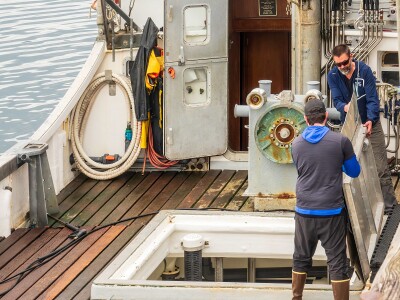Breaking the ice
Based on U.S. Coast Guard reports.
While the cold weather may seem long gone, the buildup of ice on your vessel, depending on your region, should never be too far from your mind. In January 2007, a fishing vessel and crew of four were lost in Nantucket Sound. The crew was headed home early from a fishing trip because of inclement weather.
A 75-foot western-rigged dragger was fishing out of New Bedford, Mass. On Jan. 23, the crew left port for a routine groundfishing trip in the vicinity of Cultivator Shoal on Georges Bank. The seasoned skipper and crew members, each with 25 years or more of fishing experience, had made the voyage many times.
In the late afternoon of Jan. 26, the skipper contacted the vessel's owner via satellite phone and informed him that he decided to cut the trip short and return to port because of the deteriorating weather. The National Weather Service's offshore weather forecast predicted gale-force winds of 25 to 30 knots with gusts up to 40 knots. The seas were forecast to be between 6 and 9 feet with freezing spray likely. The conditions were expected to continue into the next day. The skipper also informed the owner that the vessel was icing up. This was the last voice transmission from the dragger.
At 10:56 that night, Boatracs, an electronic vessel position monitoring system, received an automatic position contact report from the vessel. At 11:26, when Boatracs had not received the scheduled 30-minute position report, it initiated an automated two-hour alarm countdown. In that two hours, the dragger could not be contacted. Boatracs then contacted three fishing vessels in the area and requested that they attempt to contact the dragger.
At 5:06 a.m. on Jan. 27, after numerous unsuccessful attempts to contact the missing vessel by radio, one of the other vessels called Boston's Coast Guard Command Center and informed them of the situation. The information was relayed to the southeastern New England sector, which tried unsuccessfully to contact the vessel. After verifying that the vessel was not in port in New Bedford, a helicopter from Air Station Cape Cod initiated a search of the last known position of the dragger. The helicopter crew observed an oil sheen on the surface of the water, but could not locate missing vessel. A Coast Guard rescue boat later discovered debris in the area.
The next day, divers found the vessel submerged in approximately 56 feet of water. It was 12 miles from Woods Hole. On Jan. 29, the Coast Guard suspended its search for survivors. Police divers recovered the body of the skipper from the pilothouse. Another body was recovered from the vessel on Feb. 21. Both individuals were determined to have drowned.
The dragger was raised April 25. Investigators searched the vessel and could not find the two missing crew members. A preliminary assessment of the dragger identified no probable cause or mechanical or hull failure. All required safety and lifesaving equipment was accounted for or had been recovered during the dives.
Lessons learned
By all accounts, the dragger was well maintained. In April 2006, it completed a Coast Guard Fishing Vessel Safety Exam and was issued a safety decal after replacing an expired hydrostatic release on the EPIRB and the indicating light for the bilge alarm in the pilothouse. The owner, operator and crew were conscientious about safety, preparedness, and keeping the vessel and its equipment in good operating condition. The skipper had completed drill conductor training. He and two crew members had completed a safety and survival training course. Records from the vessel indicate monthly emergency drills and regular familiarization training, and the EPIRB had just been inspected and tested. It appeared the crew should have been ready to respond to an emergency.
The Coast Guard determined that the dominant cause for the sinking of the vessel was a drastic decrease in stability from the additional weight of a significant accumulation of ice. The environmental operating conditions — high wind speed, low air and water temperatures, and wind direction relative to the vessel's heading — created a serious sea spray icing hazard. A change in the vessel's heading may have helped reduce ice accumulation.
The recent addition of a boom and bulwarks increased surface area on the vessel that would have allowed for more ice accumulation. The added weight high on the vessel most likely had a negative effect on the vessel's stability, specifically its ability to right itself. The arrangement of the boom and other structural features would have made ice removal difficult and dangerous. Other operators in that area around the same time reported severe icing conditions and difficulty breaking ice from their vessels.
The crew may not have been fully aware of the conditions. The skipper and a crew member recovered from inside the vessel were found wearing only light clothing. The two missing crew members were most likely on deck breaking ice, because the outside doors were closed. Four survival suits were found still in their storage bags — three in the pilothouse and one in the skipper's cabin. If the captain and crew members had realized their vessel was in such peril, preparing and/or donning their immersion suits and making the life raft and EPIRB ready for deployment would have improved their chances of survival.
The life raft and EPIRB on the vessel did not release when the vessel sank, most likely because they were encased in ice and could not float free as designed and installed. When divers discovered the sunken vessel, it was resting on its side. The hydrostatic release and strap were lying in a released condition, but the life raft was lodged in its cradle. When a diver bumped it, the life raft floated to the surface. Similarly, the EPIRB had released from its mounting but had become trapped in a scupper. It appeared the hydrostatic releases failed to deploy the safety equipment until after the vessel had gone down and the accumulated ice melted. In icing conditions, crews should make sure deployable safety equipment is kept free so they will be able to deploy as designed.
To prevent or reduce ice buildup and help maintain vessel stability: 1) Ensure freeing ports are kept clear to allow drainage of water on deck; 2) keep bilges pumped to minimum level to reduce free surface effect; 3) break ice off surface areas of the vessel if possible (ice accumulation on a vessel tends to increase the rate of further accumulation); 4) maneuver the vessel to minimize creating freezing spray; and 5) seek a location where environmental conditions are less severe. Also, crews should make sure all gear is properly and securely stowed.
Whenever a vessel is altered or modified, and equipment and gear is added to facilitate operation in different fisheries, owners and operators must make sure they understand how those changes affect the stability of the vessel. Have a naval architect perform a stability analysis so you and your crew understand the vessel's limits, handling abilities and characteristics.
Always be aware of hazardous situations you may encounter, and have a plan. Anticipate the worst and be prepared to take corrective action before it becomes an emergency. Conduct regular emergency drills and provide instruction on the proper deployment, use and maintenance of all of the important safety equipment on your fishing vessel.
For information on safety items and issues, visit www.fishsafe.info.






